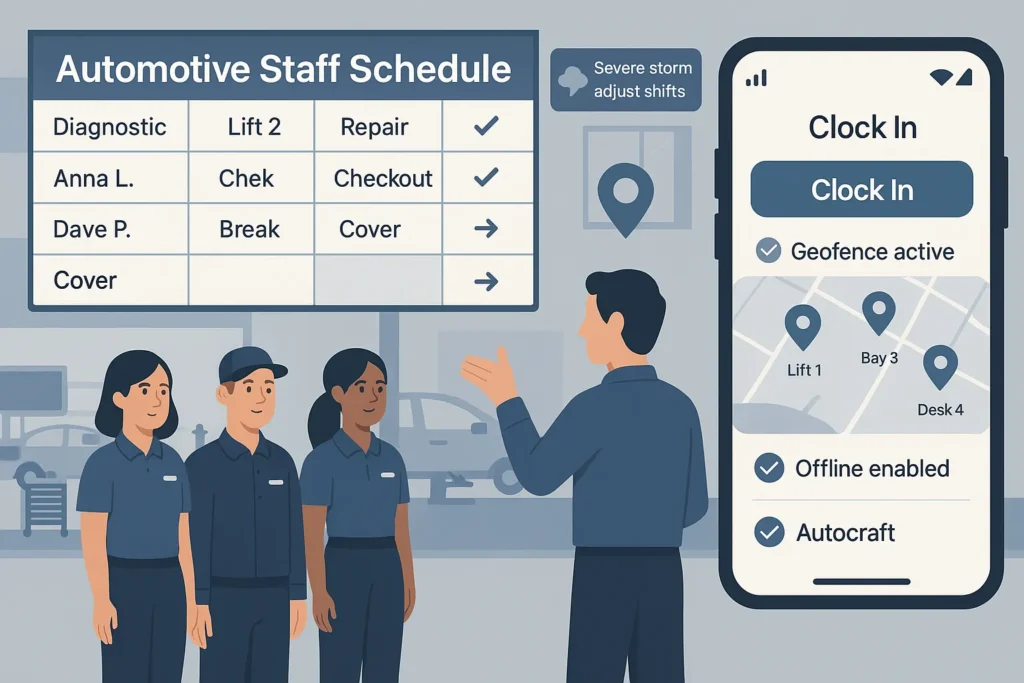Running an automotive business today is complex. Factories, workshops, dealerships, and logistics units all depend on people. Mechanics, drivers, warehouse teams, and service staff must work in sync. A single delay can disrupt the supply chain, slow down repairs, or leave customers waiting. That is why companies in the automotive industry — and many others like retail, logistics, and services — need smarter ways to plan work. An Automotive Staff Schedule is more than a calendar. It is the foundation for smooth operations, fair workloads, and better customer service.
Problems Without a Scheduling System
When staff are managed with spreadsheets, sticky notes, or last-minute calls, problems multiply:
Shift confusion: mechanics arrive late because schedules were unclear.
Excess overtime: drivers cover too many routes, leading to fatigue and higher payroll.
Payroll errors: hours tracked by hand cause disputes and frustration.
Poor communication: staff do not see changes when production shifts are adjusted.
Coverage gaps: service desks or warehouses are left short-staffed at peak hours.
These problems waste time, increase costs, and reduce trust between managers and employees. For industries where timing and precision matter, this is too risky.
What an Automotive Staff Schedule Really Means
An Automotive Staff Schedule is a digital system that tells who works, when, and where. Unlike static rosters, it adapts in real time and gives managers control over complex workflows.
For automotive operations, this means aligning teams across production, repair shops, and distribution hubs. For other industries, it means keeping staff in the right place at the right moment.
Practical scenarios show why it matters:
Unexpected delays: a delivery truck breaks down. The system instantly reassigns another driver and alerts warehouse staff.
Night rotations: factories run 24/7, so night teams must be scheduled fairly and safely.
Last-minute replacements: a technician calls in sick, and the tool notifies available standbys.
Multi-location networks: dealerships across cities share resources, and hours must be balanced across all sites.
Without automation, managers spend hours juggling calls and messages. With it, changes happen in minutes.
Key Criteria When Choosing a Solution
To truly help businesses, scheduling software must cover more than just rosters. Look for features that solve daily challenges:
Offline mode — keep working even when internet is unstable.
Mobile clock-in/out — staff record hours directly from phones.
Geofencing/GPS — confirm employees are on-site before clocking in.
Shift templates — save common schedules for quick reuse.
Roles and permissions — supervisors manage teams securely.
Mass alerts — update dozens of workers at once with one click.
Payroll exports — turn schedules into accurate timesheets.
Multi-language support — crucial for global companies.
Fast onboarding — new staff should learn the tool in minutes.
These are not “nice to haves.” They are essential for reliability and fairness.
Top 5 Solutions: Shifton and Competitors
1. Shifton — Clear Leader for Shift-Driven Operations
Shifton is built for businesses where precision and speed matter. For automotive companies, it simplifies production lines, service bays, and delivery routes. For other industries, it covers daily shift work with the same clarity.
Key strengths include:
Quick employee import for fast setup.
Team templates for recurring shift patterns.
Mobile notifications so no update is missed.
Clock-in/out via app, replacing paper logs.
Geofencing to confirm staff are at workshops or depots.
Reliable offline use when internet fails.
Timesheet exports that cut payroll errors.
Shift duplication and mass editing for efficiency.
Multi-language access for diverse teams.
Example for automotive: when a factory’s late shipment forces overtime, Shifton adjusts schedules and prevents unsafe fatigue.
Example for logistics: when a snowstorm delays trucks, managers reassign drivers with one click.
Example for retail: when holiday crowds surge, shifts are duplicated, and alerts keep stores covered.
Shifton blends powerful features with simplicity. That balance is rare.
2. Deputy
Deputy is known for its clean design and mobile apps. It helps with leave requests, time tracking, and quick notifications.
Strong for mid-size teams.
Easy to swap shifts.
User-friendly mobile interface.
Limits: weaker offline support and less robust geofencing. For complex, multi-site automotive networks, this can be a challenge.
3. When I Work
When I Work focuses on easy scheduling and employee engagement. Staff can request and trade shifts without constant manager input.
Great for small to mid-size operations.
Clear communication tools.
Fast adoption by teams.
Limits: not ideal for large factories or logistics hubs. Complex rotations and coverage gaps may remain hard to manage.
4. Homebase
Homebase combines scheduling with payroll basics. It is popular in food service and small retail but also useful in auto service shops.
Simple for managers.
Payroll integration.
Easy for staff to learn.
Limits: less powerful for multi-location setups. Templates and offline support are limited, making it harder for global operations.
5. Connecteam
Connecteam offers more than scheduling: it includes training and communication tools. This makes it flexible for companies wanting an all-in-one platform.
Combines shifts with messaging and training.
Works well on mobile devices.
Good for broad staff engagement.
Limits: setup can take time, and scheduling templates are not as advanced as Shifton’s. Automotive businesses may find it heavier than needed.
Comparison Snapshot
Across the main criteria, differences are clear.
Shifton stands out on offline use, geofencing accuracy, and multi-language coverage. Deputy shines in user interface but is weaker for large networks. When I Work is simple and quick but not suited for very complex rotations. Homebase is practical for payroll but lacks deep scheduling power. Connecteam is broad in features but slower to adopt.
For any company running shift-driven work, the choice depends on size and complexity. But for industries where time, safety, and accuracy are critical, Shifton delivers both speed and control.
Why Shifton Ranks #1
Automotive companies face unique challenges: multiple sites, strict safety rules, and constant changes. Shifton was built for these realities but stays simple enough for everyday use.
In factories: managers balance shifts fairly and prevent burnout.
In service shops: mechanics are assigned by skill and availability.
In logistics: routes and depots stay covered even when plans change.
In retail: busy hours never go understaffed.
In services: replacements are found in minutes, not hours.
Other tools solve parts of the problem. Shifton solves the whole picture.
Final Thoughts about Automotive Staff Schedule
In automotive, every delay spreads fast — a late delivery, a missed repair, an idle machine. In retail, an empty cashier desk costs sales. In logistics, an uncovered route breaks customer trust. The answer is the same: a reliable Automotive Staff Schedule that adapts in real time.
Shifton leads this space by blending ease of use with the power needed for complex operations. Deputy, When I Work, Homebase, and Connecteam each offer useful features, but none match Shifton’s full balance of clarity, control, and speed.
For any business — from automotive factories to logistics hubs, from retail stores to service providers — the right schedule means more than hours on a page. It means trust, safety, and smooth operations. With Shifton, these goals are within reach.

 English (US)
English (US)  English (GB)
English (GB)  English (CA)
English (CA)  English (AU)
English (AU)  English (NZ)
English (NZ)  English (ZA)
English (ZA)  Español (ES)
Español (ES)  Español (MX)
Español (MX)  Español (AR)
Español (AR)  Português (BR)
Português (BR)  Português (PT)
Português (PT)  Deutsch (DE)
Deutsch (DE)  Deutsch (AT)
Deutsch (AT)  Français (FR)
Français (FR)  Français (BE)
Français (BE)  Français (CA)
Français (CA)  Italiano
Italiano  日本語
日本語  中文
中文  हिन्दी
हिन्दी  עברית
עברית  العربية
العربية  한국어
한국어  Nederlands
Nederlands  Polski
Polski  Türkçe
Türkçe  Українська
Українська  Русский
Русский  Magyar
Magyar  Română
Română  Čeština
Čeština  Български
Български  Ελληνικά
Ελληνικά  Svenska
Svenska  Dansk
Dansk  Norsk
Norsk  Suomi
Suomi  Bahasa
Bahasa  Tiếng Việt
Tiếng Việt  Tagalog
Tagalog  ไทย
ไทย  Latviešu
Latviešu  Lietuvių
Lietuvių  Eesti
Eesti  Slovenčina
Slovenčina  Slovenski
Slovenski  Hrvatski
Hrvatski  Македонски
Македонски  Қазақ
Қазақ  Azərbaycan
Azərbaycan  বাংলা
বাংলা 


